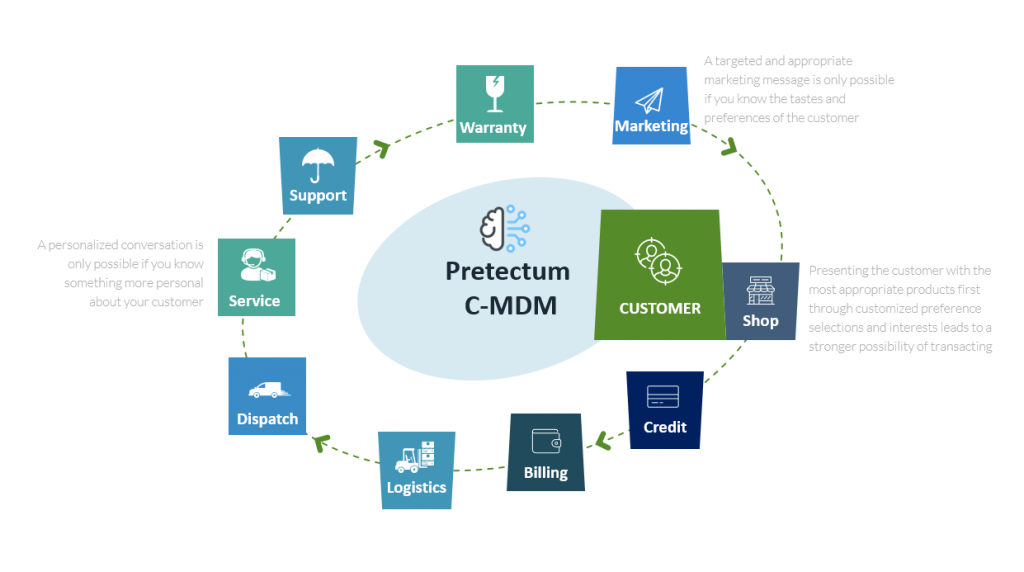Few would challenge the assertion that customer data serves as both the backbone and blueprint of an organization’s operations and customer interaction.
Consider then then, how customer data content, much like a series of photocopies, is susceptible to a gradual erosion over time. In this analogy you could relate to the phenomenon of data deterioration and the progressive deterioration of image of a photocopy or the pixelation that occurs when reducing the resolution of a digital image.
This might resonate deeply within the realm of data management. Data deterioration and erosion is the result of multifaceted mechanisms, sometimes it is copying, duplicating, and cloning other times it is just neglected and like natural compounds like rubber, it perishes over time. Shedding light on this phenomenon can significantly impact how you think about the management of customer and consumer data.
With Pretectum CMDM we’ll explore strategic steps that can be taken to proactively prevent, alleviate, or even remediate the challenges posed by the gradual degradation of your customer data’s integrity.
Understanding the Nuances of Data Erosion through Replication
At the heart of comprehending data erosion is an appreciation for its parallels with the act of repeatedly copying. Just as each successive duplication introduces small inconsistencies and deviations from the original, leading to a steady deterioration in the quality of the replicated image, the digital realm is not exempt from the same principle. The very essence of data replication, duplication, or cloning carries with it the potential to introduce minor discrepancies that accumulate over time, gradually chipping away at the accuracy and reliability of the content. This phenomenon becomes even more pronounced when data undergoes migration across disparate systems or platforms, increasing the likelihood of encountering compatibility issues and data corruption.
The nexus of Data Deterioration and Customer Information Centricity
Data-driven insights fuel strategies, the significance of customer and consumer data therefore cannot be overstated. The troves of information that exist in your customer data repositories serve as the bedrock upon which targeted marketing, personalized customer experiences, and informed decision-making are built. However, the same forces that give rise to data deterioration apply just as strongly to customer data. As customer data is propagated across databases, integrated into systems, and cloned for various purposes, the lurking risk of errors and inaccuracies presents a considerable challenge. The implications of inaccurate customer data are far-reaching, from misguided marketing campaigns and subpar customer interactions to potential legal compliance breaches under compliance and regulatory frameworks.
The broad ramifications of Data Deterioration
The gradual decay of data quality directly impacts the accuracy of decision-making processes especially when organizations choose to operate with what they have oblivious to whether it is inaccurate or outdated. Tactical moves and strategies devised on such compromising foundations may lead to missed opportunities and misguided decision trajectories.
Inaccuracies within customer data can lead to not just misdirected communications and misguided marketing endeavours but can also lead to the erosion of the trust that underpins strong customer relationships and, consequently risks tarnishing the brand in relation to credibility.
Data integrity’s erosion isn’t solely a matter of operational efficiency though; it extends into the realm of compliance. Inaccurate data could lead to breaches of data protection regulations, thereby inviting legal consequences and reputational damage.

Mitigating Data Erosion: Strategies for Resilient Data Management
Establishing a robust data governance framework is paramount. This involves setting guidelines for data accuracy, consistency, and integrity throughout its lifecycle. Regular audits and data cleansing efforts are crucial to eradicate redundant or obsolete records. Pretectum CMDM contributes to governance by establishing schemas that define the business data rules for the data and accompanies the data ingestion and loading actions with statistical data quality analysis and reporting.
When you leverage the power of automated data integration tools to ensure seamless, accurate, and error-free transfer of data across systems you minimizes the chances of human-introduced errors during data migration. Pretectum CMDM does this through the orchestration of integration via four different integration patterns.
The importance of effective metadata management can also not be overstated, the ability to track data lineage and changes provides transparency, traceability, and accountability in the face of data replication. Pretectum CMDM achieves this through inherent relationship analysis describing the interrelated nature of business areas, schemas, datasets and duplicate data analysis results.
Adhering to standardized data formats, uniform naming conventions, and consistent coding practices is pivotal to preventing discrepancies during the replication process; in the context of Pretectum CMDM this is achieved through the combination of business area data, schema definitions, attribute level definitions of what is acceptable and data classifier tagging.
Consistent backups of critical data stand as a bulwark against data deterioration, Pretectum CMDM takes care of this for you as a SaaS offering. Should the worst happen and data erosion occurs, having a clean, accurate version to restore to in a point in time becomes a critical asset. The Pretectum approach as a continuous duty multi-tenanted SaaS CMDM is to drive to fixing forward or roll back to a point in time for specific datasets and records. A full auditable history of change is integral to the architecture.
Continuous monitoring of data quality and periodic audits are non-negotiable practices. They allow for the swift identification and rectification of data deterioration, minimizing its potential impact. Pretectum CMDM supports you in these objectives by continuous audit and through data quality monitoring as you go; from single to bulk record handling scenarios.

The human factor in data management is paramount, having a simple, clean interface with easy to use concepts gives you what we call “the Pretectum advantage“; this accelerates training and adoption for your business users. Proper training of individuals responsible for data handling is essential. Educating staff about data management best practices underscores the importance of accuracy and responsible data stewardship.
Organizations that maintain consumer data must internalize the gravity of maintaining data accuracy and integrity, recognizing that this integrity is the bedrock upon which informed decisions, strong customer relationships, and regulatory compliance are founded.
By rigorously implementing sound data governance practices, harnessing the potential of automation, and nurturing a culture of data quality, organizations can effectively counter the gradual erosion of data content; all of which are supported by the Pretectum CMDM, they assure that their customer data assets retain their reliability and efficacy throughout their life-cycle, thereby contributing substantively to their enduring success in a data-driven world.


